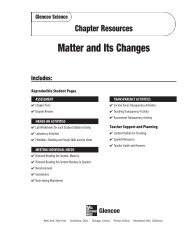Weathering and Erosion - Learning Services Home
Weathering and Erosion - Learning Services Home
Weathering and Erosion - Learning Services Home
You also want an ePaper? Increase the reach of your titles
YUMPU automatically turns print PDFs into web optimized ePapers that Google loves.
Name Date Class<br />
1<br />
Enrichment<br />
Rain Forest Soils<br />
Copyright © Glencoe/McGraw-Hill, a division of the McGraw-Hill Companies, Inc.<br />
Tropical rain forests are very hot <strong>and</strong><br />
steamy places. The average annual temperature<br />
is about 25°C. Rainfall is usually<br />
between 150 cm <strong>and</strong> 350 cm per year, with<br />
the greatest rainfalls reaching 900 cm per<br />
year or more. Many different living things<br />
flourish in these warm, moist conditions, but<br />
there is a difficult side to these conditions,<br />
too. While the plentiful rain <strong>and</strong> warm<br />
temperatures nurture a wide variety of plants<br />
<strong>and</strong> animals, they also make it particularly<br />
difficult for tropical rain forests to recover<br />
from deforestation.<br />
The problem is that plants <strong>and</strong> animals<br />
cannot use all the water that falls as rain, <strong>and</strong><br />
the Sun cannot evaporate the excess water.<br />
Therefore, excess water runs off the soil, taking<br />
nutrients <strong>and</strong> organic material with it. As a<br />
result, the layer of soil that contains nutrients is<br />
very thin.<br />
Effects of Rapid Decomposition<br />
Leaves falling from trees are one of the<br />
many factors that influence soil nutrients. In<br />
tropical rain forests, different trees shed their<br />
leaves at different times. This means there is<br />
only a thin layer of leaf litter on the ground at<br />
any time. Decomposers, such as bacteria <strong>and</strong><br />
fungi, thrive in hot, wet conditions. The result<br />
is that leaf litter <strong>and</strong> other sources of nutrients<br />
break down quickly. Decomposers often can<br />
break down dead animals <strong>and</strong> plants within<br />
24 hours.<br />
Other plants take up the nutrients almost as<br />
soon as they are released. Rain forest trees<br />
have shallow root systems that allow them to<br />
absorb nutrients from the forest floor. They<br />
do this so rapidly that nutrients don’t have<br />
time to be stored in the soil. Therefore, unlike<br />
soil in temperate forests, the humus layer of<br />
rain forest soil is very thin.<br />
Effects of Deforestation<br />
As long as trees <strong>and</strong> plants growing in forest<br />
soil can quickly absorb the nutrients, many<br />
living things can thrive in these conditions.<br />
When rain forests are cleared for farming or<br />
cattle grazing, however, the soil can support<br />
crops or grasses for only a few years. By then,<br />
most of the remaining nutrients have been<br />
removed. The l<strong>and</strong> is then ab<strong>and</strong>oned. The soil<br />
is bare <strong>and</strong> exposed to the effects of rain, heat,<br />
<strong>and</strong> wind. <strong>Erosion</strong> quickly washes away the topsoil<br />
<strong>and</strong> any remaining nutrients, leaving behind<br />
a subsurface layer called laterite. This soil is<br />
colored red by aluminum <strong>and</strong> iron oxides.<br />
Exposed to the hot Sun, this layer can become as<br />
hard as concrete. It is nearly impossible for rain<br />
forests to regrow under these conditions.<br />
Meanwhile loggers, farmers, <strong>and</strong> cattle<br />
ranchers move to new areas of rain forest <strong>and</strong><br />
destruction begins again. In some areas, about<br />
2,000 trees per minute are cut down in the<br />
rain forests. Scientists estimate that an area of<br />
tropical rain forest about the size of the state<br />
of Wisconsin is being destroyed every year.<br />
1. Why would it be difficult to replant trees in an area of tropical rainforest that has been cleared?<br />
What do you think would have to be done before this could be attempted?<br />
2. How would the soil in a tropical rainforest be different from the soil in a tropical forest that has<br />
a wet season <strong>and</strong> a dry season?<br />
Meeting Individual Needs<br />
<strong>Weathering</strong> <strong>and</strong> <strong>Erosion</strong> 29














